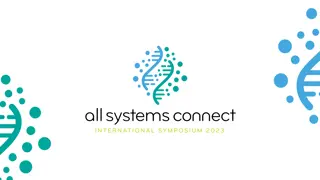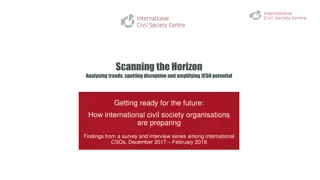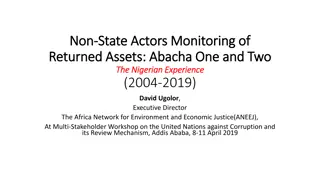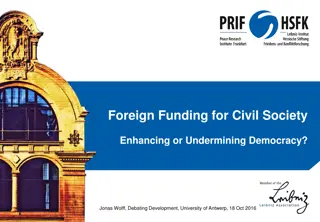Strengthening Financial Management of Civil Society Organizations Workshop
This workshop covers a comprehensive financial management module including financial reporting mechanisms, NPO conceptual frameworks, and definitions. It explores NPO registration requirements, SLFRS framework compliance, and analyzing NPO financial statements for evaluating financial conditions.
Download Presentation

Please find below an Image/Link to download the presentation.
The content on the website is provided AS IS for your information and personal use only. It may not be sold, licensed, or shared on other websites without obtaining consent from the author.If you encounter any issues during the download, it is possible that the publisher has removed the file from their server.
You are allowed to download the files provided on this website for personal or commercial use, subject to the condition that they are used lawfully. All files are the property of their respective owners.
The content on the website is provided AS IS for your information and personal use only. It may not be sold, licensed, or shared on other websites without obtaining consent from the author.
E N D
Presentation Transcript
Workshop on Strengthening Financial Management of Civil Society Organizations August 25 August 25 September 27, 2021 September 27, 2021 27 Lesson Hours in 17 Days 27 Lesson Hours in 17 Days Fin Module (Through Virtual Meeting (Through Virtual Meeting Zoom Technology) Fin Module Zoom Technology)
Module 4: Financial Reporting Mechanism Module 4: Financial Reporting Mechanism Lesson 8: Lesson 8: Overview of Financial Reporting and Financial Reporting Framework for NPO including Audited Financials and Non Profit Annual Report September 13 September 13 Lesson 9: Lesson 9: Conceptual Framework for Financial Reporting in terms of Sri Lanka Statement of Recommended Practice for Not-for-Profit Organizations and NGOs September 14 September 14 Lesson 10: Lesson 10: Financial Reporting Requirements in terms of SLFRS Framework September 15 September 15 Lesson 11: Lesson 11: NPO Specific Provisions and Significant Accounting Policies Recommended for Not-for-Profit Organizations September 16 September 16 Lesson 12 : Lesson 12 : Analyze a Non Profit Financial Statement as to Evaluate Financial Conditions for a NPO September 17 September 17
Conceptual Framework for Financial Reporting in terms of Sri Lanka Statement of Recommended Practice for Not-for-Profit Organizations and NGOs - Definition of an NPO Definition of an NPO Not-for-Profit Organizations (NPOs) are also often referred to as Development Organizations , Private Voluntary Organizations , Civil Society Organizations Non Governmental Organizations , Non-Profit Organizations , Charities and other similar terms. The requirement to register under the VSSO Act applies to all charities and humanitarian agencies. They can also be registered under the Companies Act or the Trust Ordinance (as Trusts or Foundations) as referred under legal framework
Conceptual Framework for Financial Reporting in terms of Sri Lanka Statement of Recommended Practice for Not-for-Profit Organizations and NGOs - Definition of an NPO Definition of an NPO Act No. 31 of 1980, Voluntary Social Service Organization Act has defined non-governmental organizations in the following manner. Accordingly, any organization; that has been formed on a voluntary basis by a group of individuals and are of non-governmental in nature, that depend on public contribution, charity, governmental aid and local and foreign donations in performing its activities, that has as its main objective, providing aid and services for mentally handicapped or physically disabled persons, the poor, orphans and the destitute and providing relief in times of natural disaster can be called a non-governmental organization.
Conceptual Framework for Financial Reporting in terms of Sri Lanka Statement of Recommended Practice for Not-for-Profit Organizations and NGOs - Definition of an NPO Definition of an NPO The common salient features of the NPOs to which this SL The common salient features of the NPOs to which this SL SoRP are: are: SoRP would apply would apply (a) They are voluntary organizations, either local (to a particular area), national or international; (b) They have formulated specific objective(s) to the benefit of the general society, a particular vulnerable group of the society, or to particular identified interest or target groups; (c) Their objectives are not profit oriented, unlike that of business entities;
Framework for the Preparation and Presentation of Financial Framework for the Preparation and Presentation of Financial Statements Statements - -Definition of an NPO Definition of an NPO Lanka Statement of Recommended Practice for Not-for-Profit Organizations and NGOs - Definition of an NPO Definition of an NPO Conceptual Framework for Financial Reporting in terms of Sri The common salient features of the NPOs to which this SL The common salient features of the NPOs to which this SL SoRP SoRP would apply would apply (d) Profit may be generated in a NPO, but since there are no ownership interests, it is not distributed to those providing the resources; (e) They solicit and receive financial support for promotion of the organization's objective(s) or purpose, either from individuals (or groups of individuals) in society, corporate entities, governmental entities, international organizations or agencies of sovereign states; (f) Financial dispositions are made for the purpose of promoting the objective(s) of the organization;
Donations/Contributions, Grants Donations/Contributions, Grants Donations and/or contributions from donor organizations or individuals, and government grants constitute an important part of NPO resources. An obligation, for example to deliver or perform specified service or work, is often attached to these contributions, and in such an event should be regarded as part of restricted funds . Donations/contributions from individuals or institutions create: a moral obligation, by which ever way it is received; a legal obligation to use the funds for what it was solicited; and Restricted Funds, where usage is specified.
Donations/Contributions, Grants Donations/Contributions, Grants A contribution (donation or grant) should not be recognized as an incoming resource, until there is reasonable assurance that the contribution will be received, and where relevant that the organization has or will comply with the condition(s) attached to it. Receipt of the funds does not by itself provide conclusive evidence that the conditions attached to the contribution have been or will be fulfilled. Until the conditions have been fulfilled, the contribution should be regarded as part of Restricted Funds.
Donor Agreements Donor Agreements Most NPOs enter into formal agreements or contracts with donors, thereby committing themselves to deliver/perform service/work to be financed by the respective donors. The agreement or contract will provide a detailed description of what, where and when specified activities are to take place. A corresponding budget and a list of terms and conditions, including for example reporting requirements, almost always constitute an essential part of the agreement entered into.
Donor Agreements Donor Agreements In addition to audited Financial Statements, a Variance Report, comparing actual expenditure with the approved budget, together with a corresponding narrative Progress Report, covering the same activity and period as the Variance Report, are also often demanded. These reports often constitute an essential part of the requirements spelled out in the agreement between a donor and the NPO. These reports with the financial statements often provide a useful tool to the donor in assessing the degree of completion of the activity, and to determine whether or not agreed objectives and conditions are being achieved.
Donor Agreements Donor Agreements Restrictions, or obligations, are attached not only to those funds provided by large donor agencies, but also in many cases to contributions from individuals. In a fundraising campaign, for example, where the NPO may look to the public to raise funds for a specific cause, even while there may be no written agreements, there is a clear understanding between the parties. There is, consequently, a moral obligation to utilize the funds as announced during the campaign, and the funds raised should, therefore, be regarded as restricted.
Donor Agreements Donor Agreements Funds received as donations without any direct request being made, or without any defined terms and conditions being laid down with regard to utilization, are unrestricted. In such circumstances, there will be an unwritten agreement, that the funds will be utilized within the objectives of the NPO. In this same context, there must also be clear transparency in how much of the funds received are being used to meet the general administrative and other central office costs of the NPO.
Restricted Funds Restricted Funds Nearly all NPOs hold funds that can be applied only for particular purposes within their overall objectives. These purposes are often imposed by donors (whether it be the Government or other donors) and contained in an agreement or may be self-imposed through announcements made during the course of a fundraising campaign, the media or other similar form of communication.
Restricted Funds Restricted Funds Funds held for such specified usage are restricted funds and have to be separately accounted for in the financial statements. Income that is generated from assets held in a restricted fund will normally be subject to the same restriction as the original fund, unless the terms that imposed the original restriction specifically say otherwise.
Restricted Funds Restricted Funds A different form of a restricted fund is an endowment , which is held on trust to be retained for the benefit of the organization as a capital fund. Such funds cannot normally be spent as if it were income to the organization. The income earned from such capital may, however, be utilized for restricted or other purposes of the organization. In some instances the governing body may have a power of discretion to convert endowed capital into income.
Restricted Funds Restricted Funds In such an event, and if such power be exercised, the relevant funds become restricted income or unrestricted income, dependent upon whether the governing body, within its discretion permits the funds to be expended for any of the purposes of the NPO, or only for the specific purpose. As a restricted fund, the endowment fund should, in any event, be separately accounted for in the financial statements.
Unrestricted Funds Unrestricted Funds Many NPOs have resources, which are available for the general purposes of the NPOs as set out in its governing document. This is the NPOs unrestricted or general fund. Income generated from assets held in an unrestricted fund will be unrestricted income.
Unrestricted Funds Unrestricted Funds The NPOs governing body may earmark part of the NPOs unrestricted funds to be used for particular purposes in the future. Since the governing body has the power, at a future date, to re-designate such funds within unrestricted funds, they should be described as designated funds and, consequently, be accounted for as part of the NPOs unrestricted funds.
Accumulated Fund Accumulated Fund Oxford Dictionary of Accounting defines Accumulated Fund as A fund held by a non-profit making organization to which a surplus of income over expenditure is credited and to which any deficit is debited. The value of the accumulated funds can be calculated at any time by valuing the net assets (i.e. assets less liabilities) of the organization. The accumulated fund is the equivalent of the capital of a profit making organization .
Accumulated Fund Accumulated Fund However, although NPOs do not have ownership interests or profit in the same sense as commercial entities An organization may, during any period, draw upon resources received in past periods and still unutilized, or set aside resources for use in future periods.
Accumulated Fund Accumulated Fund Maintenance of the accumulated fund of an NPO is based on the maintenance of its financial capital. An NPO s capital has been maintained if the financial value of its net assets at the end of a period equals or exceeds the financial value of its net assets at the beginning of the period.
Accumulated Fund Accumulated Fund NPO should be able to maintain its accumulated fund to enable them to provide services to its future beneficiaries. Future resource providers may need to make up the deficiency, unless the organization has the ability to generate income, e.g. by fundraising, in order to avoid such decline.
Accumulated Fund Accumulated Fund Restricted funds constitute an important part of the accumulated fund of an NPO. It is therefore important to distinguish between the restricted accumulated fund and the general accumulated fund.
Governing Body Governing Body The governing body of an NPO is similar to the board of directors of a company. However, in the case of an NPO this may be referred to as the Board of Governors or Council of Members or some other suitable name.
Users and their Information Needs Users and their Information Needs Financial statements of NPOs are used by different persons for different purposes, and their information requirements vary considerably. Unlike in the corporate sector, NPOs have neither owners nor investors. The most common groups of users of NPO financial statement are the resource providers or contributors (i.e. the different categories of donors), beneficiaries (different target groups), suppliers/creditors, employees and the authorities.
Qualitative Characteristics of Financial Statements Qualitative Characteristics of Financial Statements Qualitative characteristics are the attributes that make the information provided in the financial statements useful to users. The four principal qualitative characteristics are understandability, relevance, reliability and comparability.
Qualitative Characteristics of Financial Statements Qualitative Characteristics of Financial Statements Understandability: Understandability: The user should be able to understand the Financial Statements. All the relevant factors should be presented including all the complex matters that are material and relevant. Important factors cannot be ignored due to their inherited complexity.
Qualitative Characteristics of Financial Statements Qualitative Characteristics of Financial Statements Relevance: Relevance: Information must be relevant to the decision-making needs of users. Information has the quality of relevance when it influences, in normal circumstances the economic decisions and in the case of NPO s the socio economic decision of users, by helping them evaluate past, present or future events or confirming or correcting their past evaluations. The relevance of information is judged by its nature and materiality.
Qualitative Characteristics of Financial Statements Qualitative Characteristics of Financial Statements Reliability Reliability: Information must be reliable if it is to be useful. Information has the quality of reliability when it is free from material error and bias and can be depended upon by users to represent faithfully that which it either purports to represent or could reasonably be expected to represent.
Qualitative Characteristics of Financial Statements Qualitative Characteristics of Financial Statements Comparability Comparability The measurement and display of the financial effect of similar transactions and other events must be consistent throughout any accounting period and over the tenure of the NPO Accounting policies employed in the preparation of the financial statements, any changes in those policies and the effects of such changes must be disclosed in the financial statements.
Qualitative Characteristics of Financial Statements Qualitative Characteristics of Financial Statements True and Fair View: True and Fair View: The financial statements should present a true and fair view of the results for the period and of the state of affairs at the end of the period. Where there is doubt that the application of any of the provisions of the SL SoRP would give a true and fair view, adequate explanation should be given in the notes to the accounts of the transaction or arrangement concerned, and the treatment adopted.
Underlying Assumptions Underlying Assumptions Going Concern Going Concern Financial statements are normally prepared on the assumption that an enterprise is a going concern and will continue in operation for the foreseeable future. Hence, it is assumed that the NPO has neither the intention nor the need to liquidate or curtail materially the scale of its operations.
Underlying Assumptions . Underlying Assumptions . Going Concern Going Concern In the event that such an intention or need exists, or for example, the NPO was formed solely to carry out a specific objective and on the conclusion of such activity will be liquidated, the financial statements may have to be prepared on a different basis and, if so, the basis used must be disclosed.
Underlying Assumptions Underlying Assumptions Accrual Basis Accrual Basis Financial statements are prepared on the accrual basis of accounting in order to meet their objectives. On this basis, the effects of transactions and other events are recognized as and when they occur (and not at the point that cash or its equivalent is received or paid). The transaction is entered in the accounting records and reported in the financial statements for the periods to which they relate.
Underlying Assumptions Underlying Assumptions Accrual Basis Accrual Basis Financial statements prepared on the accrual basis provide information to users, not only of past transactions involving the payment and receipt of cash, but also of obligations to pay cash in the future and of resources that represent cash to be received in the future. This type of information would be of relevance to users in making socio economic decisions.
How to Use this SL How to Use this SL SoRP SoRP All parts of this SL SoRP will apply to all or nearly all NPOs, which prepare accrual-based accounts. However, NPOs do not have to comply with those sections, which do not apply to them. For example, the recommendations on how to account for gifts in kind and the proceeds of trading activities will not apply to all NPOs. NPOs that do not receive any income from those sources may safely ignore the sections dealing with such matters and any other sections, which do not apply to the activities of their own NPO.
How to Use this SL How to Use this SL SoRP SoRP The main text of the SL SoRP deals with the normal accounting practice for NPOs that produce full accrual based accounts. Some NPOs will have to meet additional requirements while others may have the option of preparing briefer reports and accounts. Additional or optional requirements for: Consolidated Financial Statements and Accounting for Investments in Subsidiaries Accounting for Investments in Associates Financial Reporting of Interests in Joint Ventures
How to Use this SL How to Use this SL SoRP SoRP The main obligation of the management of NPOs in the preparation of accruals based accounts is to give a true and fair view of the incoming resources and application of resources of the NPO during the year and of its state of affairs as at the end of the year. To achieve this, the management may decide to disclose more information than is specifically listed in this SL SoRP. This may provide within the notes on accounting policy
How to Use this SL How to Use this SL SoRP SoRP Scope Scope The disclosure requirements have been separately identified throughout the SL SoRP. Generally, NPOs are excused from a particular disclosure requirement only where the item in question is not relevant. This SL SoRP is intended to apply to all NPOs operating in Sri Lanka, regardless of their size, constitution or complexity. It provides the basis for the preparation of accrual accounts to give a true and fair view. Each standard included in this SL SoRP should be considered in the context of its relevance and what is material to any particular NPO.
How to Use this SL How to Use this SL SoRP SoRP Where necessary, this SL SoRP should be adapted to meet (a) Any statutory requirements relating to the form and content of accounts; and (b) To the extent that the following exceed statutory requirements: any requirements imposed by the NPOs own governing documents (e.g. By-laws or similar); and/or any requirements imposed by agreements or contracts that may have been entered into, (e.g. donor agreements/contracts).
How to Use this SL How to Use this SL SoRP SoRP This SL SoRP recognizes the requirements of the Sri Lanka Accounting Standards with regard to recognition and measurement, while adapting them to meet with the accounting and reporting needs of the NPO sector.
Application of Sri Lanka Accounting Standards Application of Sri Lanka Accounting Standards Sri Lanka Accounting Standards (SLASs) have been identified relevant to Non-Profit Organizations. The requirements of these SLASs have been considered and amended to suit the operations and transactions of these organizations. The Sri Lanka Accounting Standards are based on International Accounting Standards
SL SoRP NPOs [including NGOs] - Illustrative Financial Statements Structure The illustrative financial statements are based on full SLFRSs. The SL SoRP sets out the components of financial statements and minimum requirements for disclosure on the face of the Statement of Financial Position and the Statement of Comprehensive Income, Statement of Changes in Reserves as well as for the Statement of Cash flows. The financial statements are accompanied by accounting policies and notes.
SL SoRP NPOs [including NGOs] - Illustrative Financial Statements Structure The purpose of the Illustrative Financial Statements Structure is to provide examples of the ways in which, requirements for the presentation of the Statement of Financial Position, the Statement of Comprehensive Income, the Statement of Changes in Reserves and Statement of Cash flows might be presented in the primary financial statements. The order of presentation and the description used for line items should be changed where necessary in order to achieve a fair presentation in each organisation s circumstances.


![❤[PDF]⚡ Civil War Talks: Further Reminiscences of George S. Bernard and His Fel](/thumb/20551/pdf-civil-war-talks-further-reminiscences-of-george-s-bernard-and-his-fel.jpg)




















